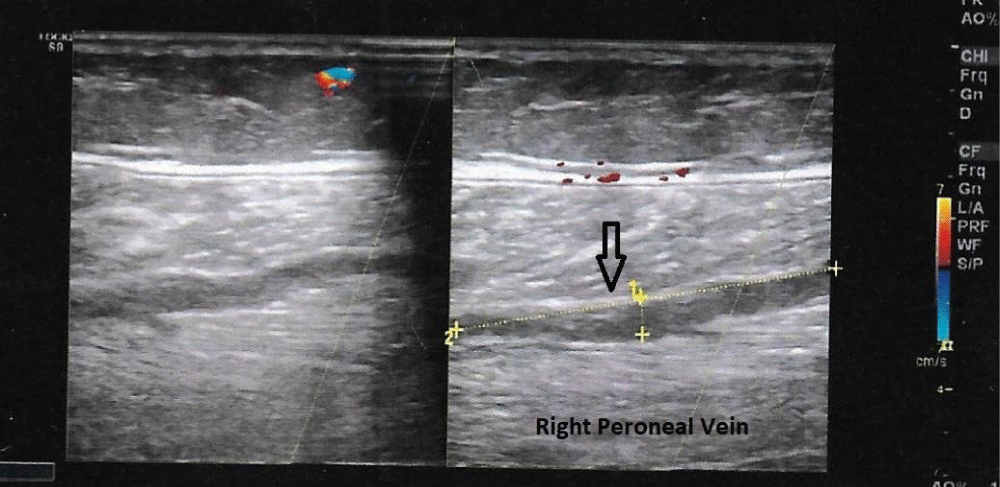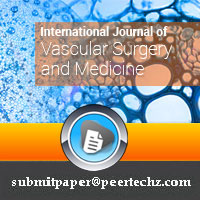International Journal of Vascular Surgery and Medicine
Recurrent Deep Vein Thrombosis in a Patient with Superficial Vein Insufficiency and Hereditary Thrombophilia
Alexandros Chamzin, Dimitrios Liakopoulos, Katerina Stylianaki, Georgios Charalampopoulos and George Galyfos*
Vascular Surgery Unit, First Department of Propedeutic Surgery, National and Kapodistrian University of Athens, Hippocration Hospital, Athens, Greece
Cite this as
Chamzin A, Liakopoulos D, Stylianaki K, Charalampopoulos G, Galyfos G. Recurrent Deep Vein Thrombosis in a Patient with Superficial Vein Insufficiency and Hereditary Thrombophilia. Int J Vasc Surg Med. 2025;11(1):001-003. Available from: 10.17352/2455-5452.000047Copyright License
© 2025 Chamzin A, et al. This is an open-access article distributed under the terms of the Creative Commons Attribution License, which permits unrestricted use, distribution, and reproduction in any medium, provided the original author and source are credited.Deep Vein Thrombosis (DVT) has been associated with high morbidity and mortality risk. It could also affect the quality of life significantly. Recurrent venous thrombosis, especially in a patient of younger age, could easily be associated with hereditary thrombophilia. Additionally, there is data that thrombophilia could be associated with chronic venous disease. When chronic venous insufficiency is present and a DVT occurs, this could increase the complexity of proper management. Therefore, this report aims to describe a case of a young woman with both hereditary thrombophilia and chronic venous insufficiency of the lower extremities, complicated with recurrent DVT. The aim is also to discuss on proper management of such complex cases.
Introduction
Deep vein thrombosis (DVT) is associated with a high morbidity and mortality risk [1,2]. Additionally, recurrent DVT ranges from 20% to 36% within 10 years from the initial event [3]. Causes of recurrent DVT may include an unprovoked first episode, malignancies, autoimmune diseases, and thrombophilia [1-3]. Therefore, in particular groups of patients, an extended duration of anticoagulant therapy may be considered to reduce the risk of recurrence [3]. Furthermore, there seems to be an association of thrombophilia with venous disease [4,5]. This could support the hypothesis that thrombophilia predisposes to the development of venous reflux and eventually venous insufficiency through the occurrence of clinical/subclinical thrombosis. In reverse, venous insufficiency predisposes to thrombosis through venous stasis [2].
This report aims to present the case of recurrent DVT in a patient with hereditary thrombophilia and venous insufficiency and to discuss proper management.
Case report
A 35-year-old female patient with a free medical history presented with sudden edema and pain in her right calf that started ten days ago. She reported a family history of thrombophilia but no written evidence was provided. Regarding clinical presentation, the calf was painful and there were no signs of pulmonary embolism. Due to moderate clinical probability for venous thrombosis (Well’s score = 2; 1 point for calf swelling and 1 for tenderness along the deep venous system) [3], the patient underwent a Duplex ultrasound. The examination revealed an ipsilateral peroneal vein thrombosis. (Figure 1) Serum D-dimer levels were increased (10,200 ng/ml; normal range <500 ng/ml).
Due to the family history, a thrombophilia testing was also scheduled. The thrombophilia exam revealed the following: heterozygous for MTHFR C677T, heterozygous for β-fibrinogen-455 G>A, homozygous for PAI-1-844 G>A, heterozygous for GPIa (C807T), heterozygous for PAI-2 C1238G, homozygous EPCR A4600G (H3) and heterozygous for LPA A5674G. Testing for other thrombophilias such as V Leiden or Protein C/S was negative. Additionally, homocysteine levels were slightly higher than normal (16 μΜ/L; reference 5-15). Testing for antiphospholipid syndrome or lupus anticoagulant was negative.
A per os anticoagulant treatment (rivaroxaban 15 mg bid for 21 days and 20mg once per day afterward) was initiated and a Class II stocking was recommended. Due to homocysteinemia, per os treatment with folic acid (5 mg per day) was also initiated. The patient remained asymptomatic and ultrasound examination after 3 months was negative for thrombus. Anticoagulants were stopped then given that this was a single episode of calf vein thrombosis and there were only minor thrombophilic mutations detected. The folic acid treatment was continued. Additionally, the patient had a significant venous insufficiency of the Great Saphenous Vein (GSV) and the ipsilateral Giacomini vein. (Figure 2) The patient was advised to further wear her stockings during work as prophylaxis.
After one year, the patient presented with similar symptoms as the first event. The ultrasound examination confirmed a recurrence of the previous thrombosis. The patient received again per os rivaroxaban (15 mg bid for 21 days and 20 mg once per day afterward). Although the symptoms subsided initially, the patient complained of recurrence of symptoms after one month. Rivaroxaban was stopped and enoxaparin (subcutaneous; 6000 units bid) was initiated. The patient’s symptoms subsided again and after 20 days on enoxaparin, per os dabigatran (150 mg bid) was initiated. The patient received extended therapy with dabigatran for at least 9 months. At 3 and 6 months, the ultrasound investigation detected no thrombus.
Additionally, we decided to treat the insufficiency to ameliorate this factor as well. The patient underwent a GSV stripping combined with a resection of the Giacomini vein. It was decided not to use an endovascular technique to avoid any thermal application given the history of thrombosis. One year after the operation, the patient remains asymptomatic.
Discussion
Thrombophilic abnormalities are found in about 30% to 40% of patients after the first episode of unprovoked DVT [3,6]. However, only if there is a family history such as in our case, a thrombophilia testing may be considered (IIaC recommendation) [3]. The most common gene alterations associated with a first episode of DVT or a recurrence are Factor V Leiden and prothrombin G20210A mutations [6]. Karathanos, et al. have demonstrated a high prevalence of C677T MTHFR and PAI-1 mutations in their patients with varicose veins concurring with our case [7]. This patient, however, had mild hyperhomocysteinemia (HCT) and a combination of heterozygous gene mutations. MTHFR mutations in combination with HCT have a prevalence of about 10% among patients with DVT and are associated with a 2-4 times higher risk for thrombosis [6,7]. Additionally, up to one-third of cases with hereditary thrombophilia and DVT will present with a recurrence within the following 4 years [6].
Regarding optimal anticoagulant treatment, there is still a lack of evidence for patients with thrombophilic factors. In the case of isolated calf DVT such as in our case, anticoagulant therapy for at least 3 months is indicated when severe symptoms or risk factors for extension are present. Otherwise, surveillance with serial ultrasound examinations without initial anticoagulation or short anticoagulant therapy (less than 3 months) could be considered in low-risk patients [2,3]. However, our patient was diagnosed with hereditary thrombophilia, and extended therapy was recommended. Besides triple-positive antiphospholipid syndrome, there is no contraindication to use novel oral anticoagulants (NOACs) as a first-line therapy in cases of thrombophilia [3]. Therefore, rivaroxaban was selected for initial treatment in the present case. Additionally, folic acid was prescribed as this significantly reduces plasma homocysteine levels [8].
In this patient, a recurrence under rivaroxaban was treated initially with enoxaparin and dabigatran thereafter. Rivaroxaban is a selective Xa factor inhibitor while dabigatran is a direct thrombin inhibitor [3]. This means that dabigatran blocks coagulation at a later stage in the cascade of thrombus formation, probably making it more potent against thrombophilias. In general, pooled data suggest that NOACs are safe and efficient in patients with thrombophilia considering VTE recurrence and bleeding risk [9]. However, the REMEDY trial has found that dabigatran is non-inferior compared to warfarin among patients with thrombophilia [10]. Therefore, dabigatran was preferred at the end for this patient.
Finally, thrombophilia being a risk factor for DVT has been associated with chronic venous insufficiency and venous ulceration [4,6]. There is evidence supporting that chronic vascular disease could develop in the context of thrombophilia following microvascular thrombosis and pericapillary fibrin cuff development [4,5]. The coexistence of thrombophilia and chronic venous disease raises the question of whether to treat venous insufficiency after treating a thrombotic event to ameliorate any possibility of recurrence. The EXACT trial has found that extended anticoagulation may reduce the recurrence risk but does not reduce the risk for post-thrombotic syndrome or improve the quality of life [11]. Additionally, venous stasis predisposes to thrombotic events [7]. Therefore, it was decided to treat the venous insufficiency as well.
Conclusion
In conclusion, patients with thrombophilia and venous insufficiency could present with recurrent thrombotic events. In these cases, both an extended anticoagulation and a surgical procedure for the treatment of insufficiency may be needed. Data for the optimal regimen are still limited for these challenging cases.
Ethical declaration
A written consent has been provided by the patient for this case report.
- Kerasidis S, Galyfos G, Kastrisios G, Stamatatos I, Stefanidis I, Giannakakis S, et al. Asymptomatic pulmonary embolism in patients with symptomatic deep vein thrombosis of the extremities: Three-year results of a prospective study. Arch Clin Exp Surg. 2016;5:1-6. Available from: http://dx.doi.org/10.5455/aces.20150809085542
- Chopard R, Albertsen IE, Piazza G. Diagnosis and treatment of lower extremity venous thromboembolism: A review. JAMA. 2020;324:1765-76. Available from: https://doi.org/10.1001/jama.2020.17272
- Kakkos SK, Gohel M, Baekgaard N, Bauersachs R, Bellmunt-Montoya S, Black SA, et al. Editor's choice - European Society for Vascular Surgery (ESVS) 2021 clinical practice guidelines on the management of venous thrombosis. Eur J Vasc Endovasc Surg. 2021;61:9-82. Available from: https://doi.org/10.1016/j.ejvs.2020.09.023
- Mackenzie RK, Ludlam CA, Ruckley CV, Allan PL, Burns P, Bradbury AW. The prevalence of thrombophilia in patients with chronic venous leg ulceration. J Vasc Surg. 2002;35(4):718-22. Available from: https://doi.org/10.1067/mva.2002.121749
- Darvall KA, Sam RC, Adam DJ, Silverman SH, Fegan CD, Bradbury AW. Higher prevalence of thrombophilia in patients with varicose veins and venous ulcers than controls. J Vasc Surg. 2009;49:1235-41. Available from: https://doi.org/10.1016/j.jvs.2008.12.017
- Santamaria MG, Agnelli G, Taliani MR, Prandoni P, Moia M, Bazzan M, et al.; Warfarin Optimal Duration Italian Trial (WODIT) Investigators. Thrombophilic abnormalities and recurrence of venous thromboembolism in patients treated with standardized anticoagulant treatment. Thromb Res. 2005;116:301-6. Available from: https://doi.org/10.1016/j.thromres.2004.12.012
- Karathanos Ch, Sfyroeras G, Drakou A, Roussas N, Exarchou M, Kyriakou D, Giannoukas AD. Superficial vein thrombosis in patients with varicose veins: role of thrombophilia factors, age and body mass. Eur J Vasc Endovasc Surg. 2012;43(3):355-8. Available from: https://doi.org/10.1016/j.ejvs.2011.12.019
- de Franciscis S, De Sarro G, Longo P, Buffone G, Molinari V, Stillitano DM, et al. Hyperhomocysteinaemia and chronic venous ulcers. Int Wound J. 2015;12:22–6. Available from: https://doi.org/10.1111/iwj.12042
- Elsebaie MAT, van Es N, Langston A, Büller HR, Gaddh M. Direct oral anticoagulants in patients with venous thromboembolism and thrombophilia: a systematic review and meta-analysis. J Thromb Haemost. 2019;17:645-56. Available from: https://doi.org/10.1111/jth.14398
- Schulman S, Kearon C, Kakkar AK, Schellong S, Eriksson H, Baanstra D, et al. Extended use of dabigatran, warfarin, or placebo in venous thromboembolism. N Engl J Med. 2013;368:709-18. Available from: https://doi.org/10.1056/nejmoa1113697
- Bradbury C, Fletcher K, Sun Y, Heneghan C, Gardiner C, Roalfe A, et al. A randomised controlled trial of extended anticoagulation treatment versus standard treatment for the prevention of recurrent venous thromboembolism (VTE) and post-thrombotic syndrome in patients being treated for a first episode of unprovoked VTE (the ExACT study). Br J Haematol. 2020;188(6):962-975. Available from: https://doi.org/10.1111/bjh.16275
Article Alerts
Subscribe to our articles alerts and stay tuned.
 This work is licensed under a Creative Commons Attribution 4.0 International License.
This work is licensed under a Creative Commons Attribution 4.0 International License.




 Save to Mendeley
Save to Mendeley
